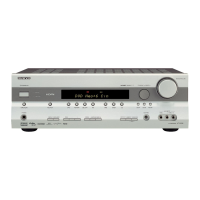50
Using the Listening Modes
—Continued
The Audio Adjust settings are explained below.
Input Channel Settings
■
Multiplex
This setting determines which channel is output from a
stereo multiplex source. Use it to select audio channels
or languages with multiplex sources, multilingual TV
broadcasts, and so on.
Main:
The main channel is output (default).
Sub:
The sub channel is output.
M/S:
Both the main and sub channels are output.
■
Mono Input Ch
This setting determines which channel is output when
the Mono listening mode is used with a stereo source.
L+R:
Both the left and right channels are output
(default).
L:
Only the left channel is output.
R:
Only the right channel is output.
PLII Music Mode Settings
These settings apply to only 2-channel (stereo) sources.
■
Panorama
With this setting, you can broaden the width of the front
stereo image when using the Pro Logic II Music listen-
ing mode.
On:
Panorama function on.
Off:
Panorama function off (default).
■
Dimension
With this setting, you can move the sound field forward
or backward when using the Pro Logic II Music listening
mode. The default value is 0. It can be adjusted from –3
to +3. Higher settings move the sound field forward.
Lower settings move it backward.
If the stereo image feels too wide, or there’s too much
surround sound, move the sound field forward to
improve the balance. Conversely, if the stereo image
feels like it’s in mono, or there’s not enough surround
sound, move it backward.
■
Center Width
With this setting, you can adjust the width of the sound
from the center speaker when using the Pro Logic II
Music listening mode. Normally, the center channel
sound is output by only the center speaker. (If you’re not
using a center speaker, the center channel sound will be
distributed to the front left and right speakers to create a
phantom center). This setting adjusts the front left, right,
and center mix, allowing you to adjust the weight of the
center channel sound. It can be adjusted from 0 to 7
(default value is 3).
DTS Neo:6 Music Mode Setting
■
Center Image
The DTS Neo:6 Music listening mode creates 6-channel
surround sound from 2-channel (stereo) sources. With
this setting, you can specify by how much the front left
and right channel output is attenuated in order to create
the center channel. It can be adjusted from 0 to 5 (default
value is 2). This setting has no effect if no center speaker
is connected.
When set to 0, the front left and right channel output is
attenuated by half (–6 dB), giving the impression that the
sound is located centrally. This setting works well when
the listening position is considerably off center. When
set to 5, the front left and right channels are not attenu-
ated, maintaining the original stereo balance.
T-D Listening Angle Setting
■
Lstn Angl (Listening Angle)
With this setting, you can specify the angle of the front
left and right speakers relative to the listening position.
Processing for the Theater-Dimensional listening mode
is based on this setting. Ideally, the front left and right
speakers should be equidistant from the listening posi-
tion and at an angle close to one of the three available
settings.
Narrow:
Select if the listening angle is 20 degrees.
Middle:
Select if the listening angle is 30 degrees
(default).
Wide:
Select if the listening angle is 40 degrees.
Multichannel Subwoofer Setting
■
SW Sens
On some DVD players, the signal from the multichannel
subwoofer output is 15 dB higher than normal. You can
change the subwoofer sensitivity to match your DVD
player. Note that this setting only affects signals con-
nected to the SUBWOOFER input jack of the multichan-
nel DVD input.
You can select 0 dB (default), +5 dB, +10 dB, or +15 dB.
If you find that your subwoofer is too loud, try the
+10 dB or +15 dB setting.
20/30/40˚
Front left
speaker
Front right
speaker
HT-R508En.book Page 50 Wednesday, March 14, 2007 10:12 AM

